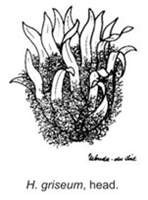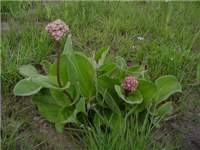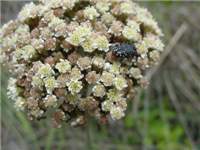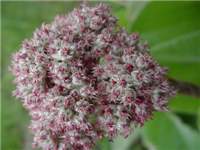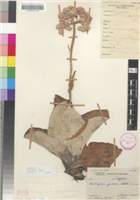Origin of name:
griseus / -a/ -um = grey
Diagnostic characters:
Large basal leaf rosetteBracts pinkOpen, branched, long-stalked inflorescence
Description:
Perennial herb, rootstock stout, woody, crown brown silky-woolly, flowering stems up to c. 700 mm high, simple, one or several tufted together, woolly-felted, remotely leafy in lower part, remotely leafy or bracteate upwards. Leaves often only 3 or 4, ascending, up to 200 x 80 mm, broadly elliptic or ovate, apex more or less acute, base somewhat narrowed in lower leaves, broad, cordate-clasping in upper, upper surface thinly cobwebby at first, later harshly pubescent, lower greyish-white felted, faintly 5�9-nerved, reticulate. Heads homogamous, campanulate, c. 6 x 5 mm, many in a congested or lax corymbose cyme. Involucral bracts in c. 4 series, subequal, closely imbricate, base woolly, tips glossy, subopaque, bright deep or pale pink or buff, very acute to acuminate, squarrose. Receptacle with fimbrils longer than ovaries. Flowers 25�31. Achenes c. 1 mm long, glabrous. Pappus bristles many, equaling corolla, scabrid, bases lightly fused.
Flowering between August and October.
Distribution:
Grows in grassland, up to c. 1200 m. From Umvoti district in KwaZulu-Natal south to East London, Eastern Cape.
Savanna and Thicket Biome.
Notes:
Most prolific after fire. Can be confused with H. pilosellum but easily distinguished by its very acute squarrose bracts.
Taxonomy:
Literature:
Helichrysum griseum Sond. in Linnaea 23: 65 (1850); Harv. in F.C. 3: 237 (1865); Moeser in Bot. Jb. 44: 262 (1910); Wood, Natal Plants 6,2: t. 549 (1910); Hilliard, Compositae in Natal 173 (1977).
Type:
Lectotype: Port Natal, Gueinzius 322 (S; G (herbarium Boiss.); P; W, isolecto.).
Synonym(s):
H. agrostophilum Klatt in Bull. Herbarium Boissier 4: 833 (1896) p.p. quoad spec. Schlechter 6216 (Z).
Vouchers:
Batten s.n. (E; K; NU); Flanagan 349 (BOL; K; SAM); Hilliard 1624 (E; NU); Pegler 86 (BOL); Rudatis 1712 (PRE).
